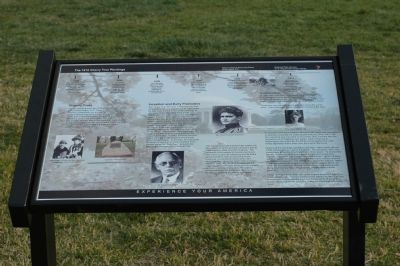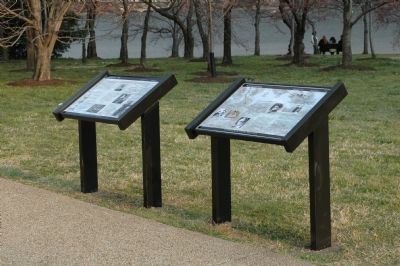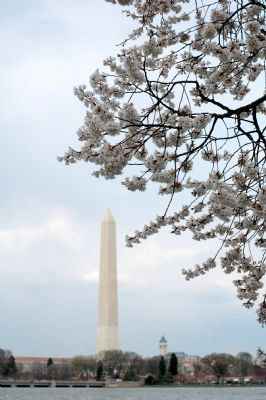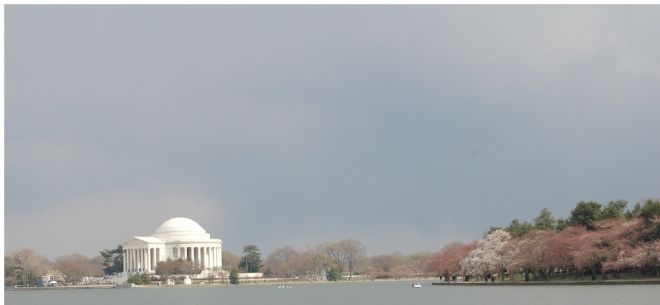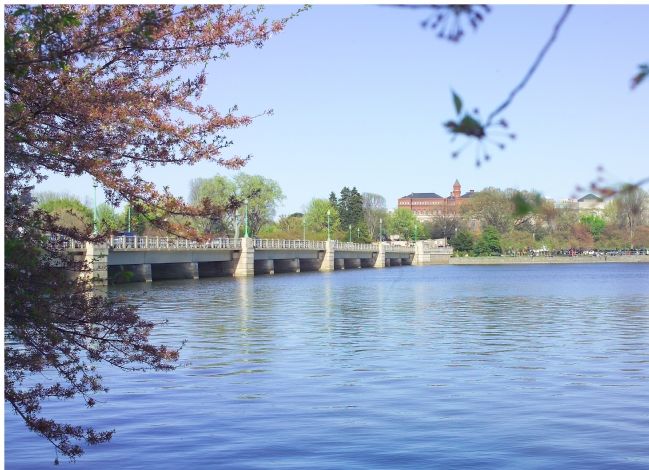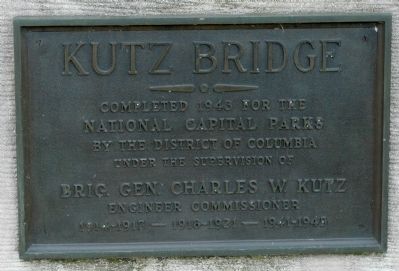The Tidal Basin in Southwest Washington in Washington, District of Columbia — The American Northeast (Mid-Atlantic)
The 1912 Cherry Tree Plantings
National Mall and Memorial Parks, Washington, D.C.
— National Park Service, U.S. Department of the Interior —
Inception and Early Promoters. Born in Lansing, Michigan, David Fairchild was employed at the U.S. Department of Agriculture. He was instrumental in the earlier plantings of Japanese flowering cherry trees in the Washington, D.C. area. Upon his 1902 visit to Japan, Fairchild, so impressed with the picturesque beauty of the cherry trees lining the waterway and streets, left determined to plant these trees on his Chevy Chase, Maryland estate. Four years later, Dr. Fairchild brought his idea to fruition by planting seventy-five flowering and twenty-five weeping cherry trees on his estate. Pleased with their hardiness, he ordered another three hundred trees for the Chevy Chase area. In 1908, Fairchild donated cherry saplings to each District of Columbia school for Arbor Day. At the time, he expressed his desire to see a procession of cherry trees planted along the "Speedway" (present day Independence Avenue) in Potomac Park.
The cherry trees help transform the capital city into a cloud of white and pink blossoms during Washington's week-long rite of spring. The hundreds of thousands of tourists and locals who come to view the blossoms should thank early promoters such as Eliza Ruhamah Scidmore, an American travel writer and photographer. Upon her return from a visit to Japan in 1885, Ms. Scidmore petitioned the Superintendent of Public Parks and Grounds to advocate planting cherry trees throughout portions of Potomac Park. Her appeals failed, yet she persevered for twenty-four years.
Culmination. In 1909, Mrs. Scidmore, in her quest to beautify Washington D.C., decided to raise the money required to purchase and donate cherry trees to the city. She sent a note to First Lady Helen Taft who responded with great enthusiasm, saying
Thank you very much for your suggestion about the cherry trees. I have taken the matter up and am promised the trees.
As the wife of President William Howard Taft, Helen was very active in working to beautify the undeveloped Potomac River. Mrs. Taft, who was born and educated in Cincinnati, Ohio, traveled with her husband to the Philippines and Japan. Upon returning to Washington, she instructed the White House gardener to plant ninety Japanese cherry trees near the Lincoln Memorial.
Hearing of the plantings, the Major of Tokyo, Yukio Ozaki, offered 2,000 cherry trees as a gift of friendship. On January 6, 1910, the cherry trees arrived in Washington D.C. from Japan. To everyone's dismay, inspection found insects and nematodes (worms). President Taft ordered the trees burned. Letters of deep regret circulated among the President, Secretary of State, and the Japanese Ambassador, and staved off a diplomatic setback. Mayor Ozaki immediately arranged for replacements, and on March 27, 1912, the first plantings of some 3,020 cherry trees commenced along the Potomac River, Rock Creek, and the White House grounds.
Today, perhaps fewer than 200 of the original trees sent by Mayor Ozaki still survive.
The two Yoshino trees planted by Mrs. Taft and Viscountess Chinda remain as a true testament to all those who persevered to create an attractive setting for Washington's cherry trees.
Erected by National Park Service, U.S. Department of the Interior.
Topics and series. This historical marker is listed in this topic list: Horticulture & Forestry. In addition, it is included in the Former U.S. Presidents: #27 William Howard Taft, and the Historic Trees series lists. A significant historical month for this entry is January 1883.
Location. This marker has been replaced by another marker nearby. It was located near 38° 53.21′ N, 77° 2.476′ W. Marker was in Southwest Washington in Washington, District of Columbia. It was in The Tidal Basin. Marker was on Independence Avenue Southwest east of West Basin Drive Southwest, on the right when traveling east. Touch for map. Marker was in this post office area: Washington DC 20024, United States of America. Touch for directions.
Other nearby markers. At least 5 other markers are within walking distance of this location. A Symbol of International Friendship (here, next to this marker); Lighting the Way (here, next to this marker); The First Japanese Cherry Trees
(within shouting distance of this marker); District of Columbia War Memorial (about 700 feet away, measured in a direct line); a different marker also named District of Columbia War Memorial (about 700 feet away). Touch for a list and map of all markers in Southwest Washington.
Additional commentary.
1. Time Line Shown on the Marker
1885 — Mrs. Eliza Ruhamah Scidmore (1856–1928) proposed planting cherry trees throughout parts of the emerging Potomac Park.
1906 — Dr. David Fairchild (1869–1954) planted 100 flowering trees on his Chevy Chase, Maryland estate.
1908 — Dr. Fairchild observed Arbor day by giving cherry tree saplings to schoolchildren in the District.
1919 — First Lady Helen Taft responded to Mrs. Scidmore's offer to donate cherry trees to improve Potomac Park.
1910 — Two thousand cherry trees from Japan arrive in Washington but were immediately burned
because of infestation.
1912 — following the arrival of 3020 replacement trees, Mrs. Taft and Viscountess Chinda planted two of them along the Tidal Basin.
— Submitted March 30, 2006.
Additional keywords. Kutz Bridge, Tidal Basin
Credits. This page was last revised on January 30, 2023. It was originally submitted on March 30, 2006, by Tom Fuchs of Greenbelt, Maryland. This page has been viewed 8,061 times since then and 74 times this year. Photos: 1, 2, 3. submitted on March 30, 2006, by Tom Fuchs of Greenbelt, Maryland. 4. submitted on April 4, 2006, by Tom Fuchs of Greenbelt, Maryland. 5. submitted on May 3, 2008, by Tabitha Preast of Hanover, Maryland. 6, 7. submitted on April 14, 2006, by Tom Fuchs of Greenbelt, Maryland. • J. J. Prats was the editor who published this page.
